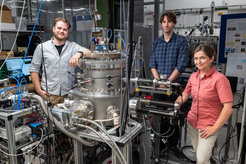In recent years, the pursuit of understanding antimatter has captivated physicists at CERN (the European Organization for Nuclear Research). The complexity surrounding antimatter, a facet of the universe built upon the principles of particle physics, has provoked intense inquiry into its properties and potential applications. This article delineates the progress made in antimatter research at CERN, touching upon the methodologies employed, findings recorded, and the implications for fundamental physics and beyond.
The fundamental distinction between matter and antimatter rests upon the behavior of subatomic particles. Antimatter resembles matter but is composed of antiparticles, which possess opposite charges and quantum numbers. The annihilation of a particle and its antiparticle yields energy as delineated by Einstein’s famous equation, E=mc². The exploration of antimatter serves not only to elucidate the fundamental symmetries of nature but also to probe questions surrounding the asymmetry observed between matter and antimatter in the universe.
At the forefront of this exploration is CERN’s Antimatter Decelerator (AD), a unique facility designed for the production and confinement of antihydrogen, the simplest form of antimatter. Antihydrogen is composed of an antiproton, which has a negative charge, and a positron, the antimatter counterpart of an electron, which possesses a positive charge. The creation of antihydrogen entails a multi-step process: antiprotons are generated through high-energy collisions, trapped, and subsequently merged with positrons. The efficiency of this process had historically faced challenges, but recent advancements have significantly enhanced production rates.
One such advancement was the implementation of cutting-edge techniques in laser cooling and the manipulation of particle beams. By employing laser technology, researchers succeeded in reducing the velocity of positrons and antiprotons. Consequently, this fine-tuning enables a higher probability of interaction, facilitating the formation of antihydrogen in increased quantities. Furthermore, improved beam extraction mechanisms have minimized losses, allowing greater control over the conditions under which antihydrogen is synthesized.
However, simply producing antihydrogen is but one aspect of the challenge. The subsequent task requires the effective trapping of antihydrogen atoms for observational studies. The ALPHA (Antihydrogen Laser Physics Apparatus) collaboration at CERN has made significant strides in developing sophisticated electromagnetic traps. These traps use magnetic fields to hold antihydrogen atoms in place long enough for detailed characterization. Advances in trap design have allowed for longer confinement times, thereby providing physicists with valuable data.
Analysis of antihydrogen’s spectral properties presents an intriguing domain of inquiry. By comparing the spectral lines of antihydrogen with those of hydrogen, physicists can examine potential discrepancies. Such investigations are critical for testing fundamental symmetries in physics, such as CPT (Charge, Parity, Time) symmetry. CPT symmetry posits that the laws governing physics should remain invariant when particles are replaced by their antiparticles, spatial coordinates are inverted, and the time direction is reversed. As such, any observed differences could hint at profound insights into the universe’s underlying mechanics.
Recent experimental results from the ALPHA collaboration have begun to shed light on these spectral comparisons. Measurements of the Lyman-alpha transition in antihydrogen have demonstrated a remarkable agreement with their matter counterparts. This parity serves to reinforce the predictions made by the Standard Model of particle physics, which has heretofore remained robust under rigorous scrutiny. Nevertheless, scientists continue to explore the bounds of this symmetry, engaging with data that may challenge established paradigms and provoke further inquiry.
Beyond the realm of particle physics, the potential applications of antimatter are tantalizingly vast. These applications range from antimatter propulsion systems for advanced space travel to novel medical imaging techniques. The utilization of positron emission tomography (PET) scans exemplifies the medical applicability of antimatter, where positrons emitted from radioisotopes are harnessed to produce detailed images of metabolic processes within the human body. Future advancements in antimatter capture may enhance this technology, leading to more precise diagnostic capabilities.
Despite the progress made, significant challenges persist within antimatter research. The production of antihydrogen, even with recent developments, remains prohibitively low and costly. Antimatter is intrinsically rare, and its annihilation upon contact with matter renders production and study logistically complex. Thus, scalability for any practical applications remains a formidable hurdle. Researchers continue to innovate, devising more efficient methods and optimizing existing technologies.
Looking ahead, the trajectory of antimatter research at CERN promises to yield groundbreaking insights. The endeavor not only strives to uncover the mysteries of the universe but also holds the potential for technological revolution. Each experimental advancement encapsulated within the walls of CERN paves the way for deeper understanding and innovative applications. As the antimatter trap tightens, the scientific community remains poised at the precipice of discovery, eager to unlock the secrets held within this elusive form of matter.












